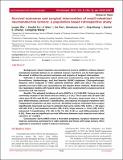Survival outcomes and surgical intervention of small intestinal neuroendocrine tumors: a population based retrospective study

View/
Author
Wu, Lunpo
Fu, Jianfei
Wan, Li
Pan, Jie
Lai, Sanchuan
Zhong, Jing
Wang, Liangjing
Published Version
https://doi.org/10.18632/oncotarget.13632Metadata
Show full item recordCitation
Wu, Lunpo, Jianfei Fu, Li Wan, Jie Pan, Sanchuan Lai, Jing Zhong, Daniel C. Chung, and Liangjing Wang. 2017. “Survival outcomes and surgical intervention of small intestinal neuroendocrine tumors: a population based retrospective study.” Oncotarget 8 (3): 4935-4947. doi:10.18632/oncotarget.13632. http://dx.doi.org/10.18632/oncotarget.13632.Abstract
Background: Small intestinal neuroendocrine tumors (SiNETs) without distant metastasis typically behave in an indolent manner, but there can be heterogeneity. We aimed to define the survival outcomes and impacts of surgical intervention. Methods: A retrospective cohort study was conducted by using data from the Surveillance, Epidemiology, and End Results (SEER) database. Clinicopathologic features were analyzed in 4407 patients between 2000 and 2012. The cancer specific survival (CSS) was calculated by the Kaplan-Meier method. Multivariable Cox regression models with hazard ratios (HRs) were constructed to analyze survival outcomes and risk factors. Results: The adjusted incidence of early SiNETs is 1.3/100,000. Tumors are most commonly located in the ileum and are small (≤ 2 cm). The 5-year and 10-year CSS rates were 95.0% and 88.5%, respectively. Age > 50 years, large tumor size (> 2cm), poor differentiation, advanced T classification, and absence of surgical treatment were independent predictors of poor survival. Stratified analysis indicated that surgery significantly improved survival in patients that were white (HR, 0.45), > 50 years old (HR, 0.61), had duodenal tumors (HR, 0.43), large tumors (> 2cm) (HR, 0.32), advanced T classification (T3: HR, 0.29; T4: HR, 0.18) or well differentiation (HR, 0.55). There was no significant survival difference between local resection and radical resection (P =0.884). Conclusions: Early SiNETs have a favorable prognosis. Surgical resection may improve outcomes, particularly in older patients and those with large tumors. More aggressive resections couldn't improve outcomes.Other Sources
http://www.ncbi.nlm.nih.gov/pmc/articles/PMC5354882/pdf/Terms of Use
This article is made available under the terms and conditions applicable to Other Posted Material, as set forth at http://nrs.harvard.edu/urn-3:HUL.InstRepos:dash.current.terms-of-use#LAACitable link to this page
http://nrs.harvard.edu/urn-3:HUL.InstRepos:32630457
Collections
- HMS Scholarly Articles [17922]
Contact administrator regarding this item (to report mistakes or request changes)


